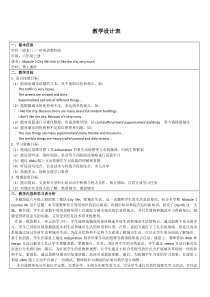 DOC
DOC
【文档说明】教科版英语六年级上册《Unit 4 I like the city very much》教案1.docx,共(7)页,1008.450 KB,由小喜鸽上传
转载请保留链接:https://www.ichengzhen.cn/view-147043.html
以下为本文档部分文字说明:
教学设计表一、基本信息学科(版本):广州英语教科版年级:六年级上册课名:Module2CitylifeUnit4Ilikethecityverymuch学时:第1课时二、教学目标1.语言技能目标:(1)能阅读城市话题的文本,从中提取信息和观点。如:Thetrafficisveryheavy
.Thestreetsarecrowedanddirty.Supermarketsselllotsofdifferentthings...(2)能根据城市的优势和不足,表达简单的观点。如:Ilikethecity.Becausetherearemany
beautifulmodernbuildings.Idon’tlikethecity.Becauseit’sverynoisy...(3)能对语篇进行可视化整理,形成思维导图,从cars\traffic\stree
ts\supermarkets\buildings等方面描述城市(4)能对城市的优势和不足加以整理和归纳。如:Thenicethingsaremanysupermarkets\manytheatreandmuseums...Theterriblethingsarehea
vytraffic\crowedanddirtystreets...2.学习策略目标:(1)能通过思维导图工具kidspiration形象生动地整理文章的脉络,归纳主要框架(2)能运用听读、限时阅读、美读等不同
的阅读策略进行语篇学习(3)通过UMU线上互动检测学生对语篇的理解和掌握(4)听说读写结合、信息技术与传统手段相结合,多元并举(5)鼓励多元、创新呈现学习收获3.情感态度目标:(1)能在提问、交流和分享的小组活动中积极与他人合作,相互帮助,共同完成学习任务(2)对城市有更深入的了解
,热爱城市,感恩城市三、教学内容和学习者分析本模块是六年级上册的第二模块-Citylife,即城市生活。这一话题和学生的生活息息相关,结合本学期Module1Countrylife这个话题,本节课教师充分利用知识的前后联系,巩固旧知
识和综合运用新知识,创设了citylife这一主题。整节课,学生在语篇中利用思维导图工具提取与城市相关的信息和观点,并且在调查和测试中习得新知识,既感受到听说读写的乐趣,又享受到信息技术带来的便利。在前一模块和上一单元的学习中,学生能够流畅地用英语描述乡村生活和城市生活的特点。通过前两
个单元的学习,学生已经较好地掌握描述乡村生活和城市生活的短语和句型,在听、说的方面打下了扎实的基础。但是还尚未系统地比较过乡村生活和城市生活,为此从优势和不足两个方面来了解城市生活,可以让学生更全面地了解城市。基于此前提,学生在课堂上通过Kidspiration制作形象生动的思维导
图来提取重点信息。课堂上,教师借助IPAD和Seewo互动白板等工具让学生理解语篇,掌握观点。并且,为培养学生的分类意识,学生通过seewo互动白板对信息进行分类和归纳。随后,为扩展学生的思维和视野,让学生通过小组合作探究的形式去扩展城市其他的一些优势和不足。紧接着,通过思维导图再次复述语篇,加深
对语篇的理解。最后,为检测学生当堂的学习效果,在课堂上利用UMU线上互动平台做了一份测试。教师将针对测试的结果对教学进行调整。本节课教师充分开展以学定教、以教导学、小组合作探究等方式,引导学生进行有效性的探究学习活动。并且还充分利用了
信息技术辅助教学,从而达到掌握知识、积累经验、提高技能,促进发展、提升英语核心素养的学习目的。四、教学重难点分析及解决措施1.教学重点(1)学生能够充分掌握描述城市优势和不足的词句(2)对城市的优势和不足进行分类和归纳(3)能根据思维导图的提示,描述城
市的特点2.教学难点(1)能根据思维导图的提示,引导学生综合运用所学知识,从各方面描述城市的特点(2)能扩展更多城市的特点3.解决办法(1)创设多种形式的活动加大学生对语篇的熟悉和理解,巩固目标语言(2)Kidspiration/UMU线上互动平台问卷调查、课堂检测等、创设
情境、强化理解、小组合作探究、交流总结促知识的生成。五、教学设计教学环节环节目标教学内容学生活动媒体作用及分析Pre-reading创设情境引入话题引出文本激发兴趣1.GreetingAskSshowtheyfeeltoday,teachersays“Ifeelexcited,doyoukn
owwhy?”2.FreetalkTellSstheplanfortheLaborDay:theteacherisgoingtotoBeijingtovisitherfriendsintheholiday.Thenaskwhatth
eythinkofthecity.3.PlaythevideoaboutBeijing4.TalkaboutBeijingGuidestudentstodothequestionnairesurveywithUMU:Doyoulikethecity?A.Ye
s,Ido.B.No,Idon’t.C.I’mnotsure5.IntroducethebackgroundofthetextIntroducetheinformationofthecharacter
1.Greeting2.SaywhattheythinkofBeijing3.WatchthevideoaboutBeijing.4.DothequestionnairesurveywithIPAD5.Knowmoreaboutthe
backgroundofthetext通过视频从视觉上对城市有初步的印象,为下文做铺垫通过UMU线上问卷调查初步了解学生对城市的印象,切入主题ofthetext,LiWeiwiththehelpofthepicturesandwor
ds.(LiLeiisfromthecountryside.Helivesonasmallfarm.Thenhegoestothecity.)Askthequestion“DoesLiLeilikethecity?”While-reading初读文本感知大意1.Listenandsilen
treading(1)Playtheaudioandguidestudentstoreaditsilently(2)AskthetwoquestionsQuestion1:Howistheholidayinthecity?Question2:DoesLiWeilikethec
ity?(3)Checktheanswerswithstudents.2.ThinkanddiscussAskstudentstwoquestions:(1)WhydoesLiWeimissthefarmsomuch?(2)What’sthedifferencebetweentheci
tyandthefarm?Guidestudentstothinkofthemandmakeadiscussion.1.Listencarefullyandreadsilently.Trytofindouttheanswersi
nthetext.Answerthequestions.2.Thinkofthesetwoquestionsanddiscussinthegroup.Sharetheirideasofthequestions.细读文本提取信息3.ReadandFillAskstudentstoreadth
etextloudly.GuidestudentstocompletethemindmapwithKidspirationwhiletheyarereading.当所有信息补充完后,继续处理细节信息:“beafraidtogooutside”“can’tgotosleep”“s
elllotsofdifferentthings”“playallday”4.Takephotosofthestudents’workandaskstudentstopresentswhattheyfindin
thetext5.Pastetheinformationcardsinthemindmap3.Readthetextloudlyandfindthekeyinformationofthemindmap.Fillintheblanksofthemindmap.4.Trytofin
dmoredetailinformationofthetextwiththeguideoftheteacher.5.Retellthekeyinformationofthetext利用Kidspiration对信息进行
补充和处理。Kidspiration相比起其他单一的思维导图工具更加生动形象,且还可添加图片,既方便又快捷,学生运用起来兴趣更高,能短时间帮助学生设计出优美的作品,省去画图的时间,更加高效aftertheteacher.归纳总结形成观点6.Classify
theinformation(1)Askstudentstodiscussthewaytoclassifytheinformationaboutthecity(2)Inviteastudenttoclassifyalltheinformation(
3)Askstudentsthequestion“Whydoyouputtheminagroup,putothersinanothergroup?”(4)Concludethewayofclassifyi
nginformation,whichistodivideallinformationinto“nicethings”and“terriblethings”(1)Discussinagroupandclassifyalltheinformationcards(2)Raisetheirhandst
oshowtheiranswer.(3)Sharetheirmethodsofclassifyingtheinformation.利用seewo互动白板中分类功能,让学生在形象的游戏场景中进行分类和归纳7.FurtherDiscu
ssion(1)Askstudentstothinkofthequestion“Arethereanyothernicethingsorterriblethingsinthecity?”(2)Playavideoaboutthecity,whichinclude
snicethingsandterriblethings.(3)Askstudentstowriteitontheworksheet(4)Askstudentstodothepresentationaboutwhattheythinkmo
re(1)Watchthevideoaboutthecity.(2)Discusswithgroupmateaboutwhattheyseeinthevideo.Concludesomeothernicethingsandterriblethings.(
3)Writeitdownontheworksheetandsharetheirideas视频插入通过Quikstory视频工具根据主题制作照片集,帮助学生拓展城市的优势和不足在语篇和视频的基础上小组合作探究城市更多的优势和不足,扩宽视野。利用see
wo实物展台,让学生向全班展示小组讨论后的成果Post-reading品读文本感知结构8.MusicreadingAskstudentstoreadthetextwithmusicalltogether.9.Learnthestruct
ureofthetextTheredpart-nicethingsThebluepart-terriblethingsThelastsentence-thesummaryThefirsttwosentences-thebeginningR
eadthetextwithmusicLearnandunderstandthestructureofthetextbytheanalysisoftheteacher整理脉络复述文本再读文章检测理解1.RetellthetexttogetherMakea
demoofthewaytoretellthetextwiththemindmap2.ScanthecodetodoatestwithUMUaboutthecomprehensionofthetextandc
hecktheresultofthetextQ1:WhereisLiWei?(单选题)A.InthecityB.InthecountrysideC.OnthefarmQ2:Whatarethestreetslikeinthecity?(
开放式问题)Q3:Whycan’tLiWeigotosleep?(单选题)A.Thetrafficisveryheavy.B.Thestreetsarecrowded.C.It’sverynoisyoutside.Q4:Whatd
oeshelikeaboutthecity?(多选题)A.ManysupermarketsB.ManybeautifulandmodernbuildingsC.ManytheatersandparksStudentsretellthetextwi
ththehelpofmindmapDothetestaboutcomprehension借用思维导图工具帮助学生顺畅地对语篇进行简洁的阐述通过UMU线上测试检测学生对语篇的理解和掌握。即时的反馈可以帮助教师当场进行解答和调整接下来的教学计划D.PlentyoffreshairQ5:
WhatwillLiWeidowhenhegoesbackhome?(单选题)A.MilksthecowsB.HelpshisparentswithhouseworkC.Seehisfriends情感升华Shareteacher’sideaofthecity:“Istilllovethecit
yverymuchandIwilltrymybesttomakeitmuchbetter.“板书设计教学流程图
 辽公网安备 21102102000191号
辽公网安备 21102102000191号
 营业执照
营业执照